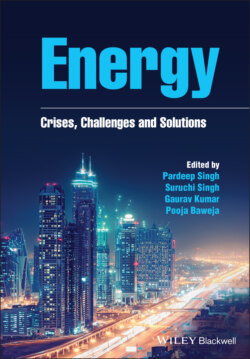Читать книгу Energy - Группа авторов - Страница 14
1.3 Role of Renewable Energy in Sustainable Development
ОглавлениеRenewable energy production has undeniably proved to be an effective and realistic approach to achieving sustainable development. Not only has renewable energy emerged as a sustainable alternative to the clean energy system with recent and rapid energy technology advances, but it is also a way to meet other socio‐economic needs, including improvising energy stability (Wei et al. 2012), mitigating climate change (Wang et al. 2014b) and minimizing environmental impacts associated with fossil fuels (REN21 2017). A total of 176 countries made efforts to realign the world’s renewable energy targets in 2016. According to available figures, renewable power accounted for around 30% of the installed capacity and 24.5% of the international level. According to projections, renewable energy accounts for 20% of the world’s energy supply (Rees 1999). In the future global energy scenario, given renewable energy’s huge technological and economic potential, it is realistic to expect a golden opportunity for renewable energy. There are real worries regarding the global energy crisis, as only small amounts of oil and gas are available and can be recovered. Natural forces generated millions of years ago non‐renewable coal, oil and natural gas reserves, and no new supplies are being developed now. So the globe will eventually also run out of those provisions, but it is still unclear when it will happen in the future. For hopeful, who believe the energy peak still exists, the challenge is to find ways to conserve the currently available energy resources to potentially postpone the upcoming peak age of oil‐gas‐fuel and find new energy sources can effectively substitute fossil fuels. Exploring renewable options available for biofuels in solar, wind, nuclear and geothermal energy is now critical. Renewables will also allow new ways of transforming the economy and efficiently replacing carbon‐free electricity. This move would take decades, but it would help restore businesses, power grids and lives associated with new energy sources.
Economic development, industrial society and the developed world’s overall lifestyle rely heavily on the energy provided by oil and gas supply. Accessible food production powered by industrial farming needs low‐cost supplies of natural gas and oil for goods and downstream purposes including pesticides, fertilizers, farming, harvesting, packaging, transport and marketing. All these big shifts in global industrial society made cheap oil energy products possible (Newton 2012). The availability of stable, skilled and reliable energy supply is essential for sustaining modern societies. Renewable energy can effectively support energy security problems at both ends, including supply and demand. Due to the finite and exhaustible state of fossil fuels, renewables can effectively meet the enormous energy demand in an increasingly important way. According to the Intergovernmental Panel on Climate Change (IPCC) study, 2.5% of renewable capacity would address a substantial 80% of world energy demand in 20 505 (IPCC 2011). On the demand side, renewables could solve energy protection, fulfil sustainability needs and be environmentally friendly. The evolving relationship between renewable energy production and energy protection has been extensively studied (Valentine 2011), evaluating the evolution of energy security concept and validating symbiosis.
Renewable energy can positively affect the climate and other beneficial social benefits, including expanded opportunities and jobs in education, reduced energy scarcity and gender disparity (Tsai and Chou 2006). Consumption of renewable energy will generate far fewer carbon emissions and harmful environmental contaminants than fossil fuels, a long way towards combating climate change and reducing environmental pollution (Varun et al. 2009; Wang et al. 2014a). Jobs figures in this energy sector grew to 9.8 million in 2016, with most countries opting for the transition to renewable energy resources, a substantial 1.1% rise over 2015 (REN21 2017). Furthermore, since access to modern and advanced energy resources is a road to sustainable growth, distributed renewable energy technologies provide unusual opportunities to alleviate energy insecurity in underdeveloped and rural areas (Wei et al. 2014).
As mentioned in the latest Organisation for Economic Co‐operation and Development (OECD)/International Energy Agency (IEA) book, almost one‐fifth of the world’s total electricity produced comes from renewable sources (OECD/IEA 2004). Renewable energy for power generation: status and prospects ‘emphasises that renewable energy, after oil (34%), coal (28%), nuclear energy (4%) and natural gas (23%) is the second most efficient energy supply around the world’ (Figure 1.1). Renewable energy growth took place from 1973 to 2000 at 9.3% annually and is expected to increase at 10.4% annually in 2010 and beyond. Wind turbines have risen to 52% most rapidly and are bound to increase further, overtake biopower and curb GHGs by developing environmentally friendly technologies (wind, solar and fuel cells). The crucial task is to minimize GHG and renewable energy generation by building broad research and development capacity in environmentally sustainable technologies. Little more than 50% of the world’s land is listed as arid and part of the rural and desert environment with no water and power grids. Here, water pumps based on diesel engines are used to supply borehole water to the inhabitants. In exchange, diesel engines are impaired by maintenance and high running costs, contributing to emissions from the atmosphere. Energy obtained from wind systems can be an acceptable alternative process.
Figure 1.1 World’s primary energy consumption in 2017.
Source: Paul Homewood, https://notalotofpeopleknowthat.wordpress.com/2017/06/19/bp‐energy‐review‐2017/.
